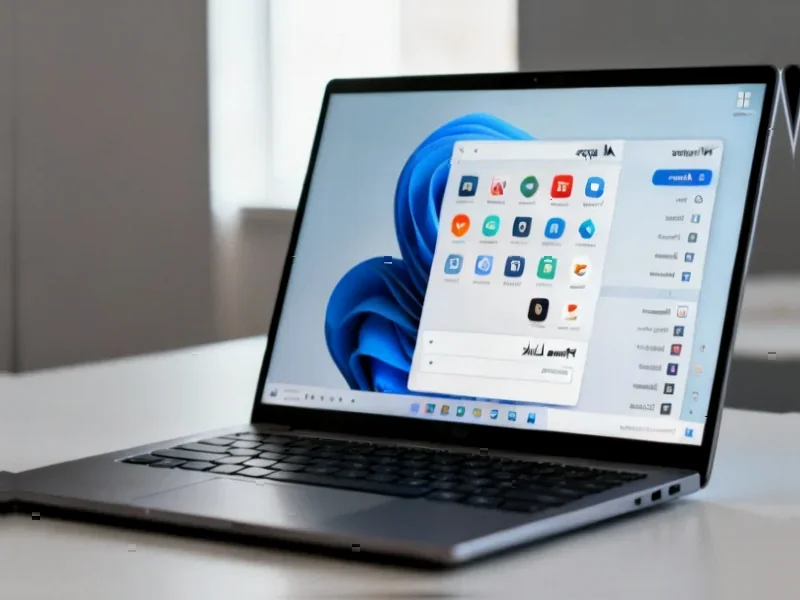According to Guru3D.com, leaked Cinebench R23 results for Intel’s upcoming Panther Lake laptop chips reveal the mid-range Core Ultra X7 358H achieves approximately 20,000 points in multicore tests, while the Ultra 5 338H scores roughly 20% lower at about 16,000 points. These early benchmarks indicate Intel may be prioritizing graphics performance and AI capabilities over raw CPU power, with the new Xe3 iGPU rumored to deliver performance comparable to an NVIDIA RTX 3050. Notably, the 358H reportedly runs about 10% slower than the older Core Ultra 255H when both operate at 60-65 watts, suggesting potential CPU performance trade-offs for improved iGPU efficiency. While these are pre-release numbers that could improve with optimization, they provide early insight into Intel’s strategic direction with Panther Lake.
Intel’s Calculated Pivot
What we’re witnessing here is Intel making a deliberate strategic calculation that reflects the changing landscape of mobile computing. For years, the industry has chased higher CPU benchmark scores, but Intel appears to recognize that most users don’t actually need more CPU power for everyday tasks. Instead, the real battleground has shifted to AI acceleration and graphics performance, particularly as thin-and-light laptops dominate the market. This pivot makes sense when you consider that discrete GPUs remain impractical for ultraportable designs due to power and thermal constraints. By focusing on integrated graphics that can compete with entry-level discrete cards, Intel is addressing a genuine market need rather than chasing benchmark supremacy that most consumers won’t notice in daily use.
The Performance Balancing Act
The reported 10% regression in CPU performance compared to previous generation parts operating at similar power levels raises important questions about Intel’s thermal and power management strategy. This isn’t necessarily about raw silicon capability—it’s about how Intel allocates that limited power budget. In mobile processors, every watt matters, and dedicating more power to the GPU inevitably means less available for CPU cores. The critical question becomes whether Intel’s power management algorithms can dynamically shift resources effectively between CPU and GPU workloads. Historical precedent suggests this balancing act is notoriously difficult to master, and early implementations often struggle with latency issues when switching between processing modes.
Market Positioning Challenges
Intel faces significant marketing challenges with this approach. While the technical rationale makes sense, consumers and reviewers have been conditioned to expect generational CPU performance improvements. A regression, even if temporary or situational, could damage perception at a time when Intel desperately needs positive momentum against AMD’s Ryzen mobile processors. The comparison game becomes particularly tricky—while having RTX 3050-level integrated graphics sounds impressive, most buyers won’t understand the CPU performance trade-off. Intel will need to carefully message that Panther Lake represents a different kind of performance, one focused on real-world use cases rather than synthetic benchmarks. This represents a fundamental shift in how we evaluate processor success in the mobile space.
The Integration Challenge
Integrating high-performance graphics onto the same package as CPU cores creates substantial engineering challenges that could explain some of the early performance characteristics. Memory bandwidth becomes a critical bottleneck when both CPU and GPU are competing for the same resources. According to detailed specifications from Laptopreview Club, Panther Lake’s memory subsystem will need to handle significantly higher bandwidth demands than previous generations. Thermal management also becomes exponentially more complex when you’re trying to cool both high-performance CPU cores and a powerful integrated GPU within the same thermal envelope. These integration challenges often manifest in early engineering samples as conservative power settings or performance limitations that get resolved closer to launch.
The AI Arms Race Context
Panther Lake’s apparent focus on AI acceleration over traditional CPU metrics reflects the industry-wide scramble to capitalize on the AI PC trend. Every major player is racing to integrate NPUs and AI accelerators, but the market hasn’t yet standardized how to measure or value this capability. Intel’s gamble assumes that AI performance will become the new benchmark by which mobile processors are judged, but this transition could take several product generations. In the interim, they risk losing ground in traditional performance metrics that still dominate purchasing decisions and review scores. The success of this strategy hinges entirely on whether software developers rapidly adopt AI-accelerated features that provide tangible user benefits—something that’s far from guaranteed given the fragmented state of AI software development.
Realistic Expectations
While early benchmarks often improve significantly before launch, the fundamental architecture decisions in Panther Lake suggest this performance profile is intentional rather than a temporary issue. Intel appears to be betting that most users will value competent gaming and content creation capabilities over marginal CPU improvements. The real test will come when we see how these chips handle mixed workloads and whether Intel’s power management can deliver the right performance at the right time. If successful, Panther Lake could redefine what we expect from integrated graphics and establish a new category of truly capable thin-and-light laptops. If not, it could represent another misstep in Intel’s ongoing efforts to regain mobile computing leadership.




